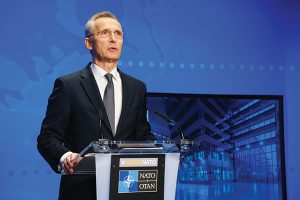Bloomberg
With international tensions high over the Kremlin’s massing of troops towards its border with Ukraine, there’s an important difference from the way Russian media treated a similar build-up last year: Moscow’s main focus now is Nato, rather than Kyiv.
The conclusion comes from a new data analysis of articles in “.ru†Internet domain names by Semantic Visions, a Prague-based data analytics company that offers risk assessment to corporations.
That the North Atlantic Treaty Organization should appear more in Russian coverage of the current buildup fits with the way Moscow has this time put retrenchment by the military alliance at the heart of its written demands to the Biden administration. There were no such demands last Spring.
The fact that hostile coverage of Ukraine itself has been less prominent may also support the argument that Russian President Vladimir Putin has – as his government publicly insists – no plans to declare war on Ukraine and is instead moving troops to stoke a sense of crisis, so as to strengthen his diplomatic hand with the West.
The analysis comes as updated data from a similar exercise at the start of the year showed that a sharp decline in hostile Russian media coverage of the Ukraine tensions during the weeks to January 5 has since reversed. That’s a potentially discouraging sign, given that governments tend to use media to prepare their populations for conflict with another state.
Yet that picture changes once the US and Nato are stripped out of the search. The recent rise in negative Russian coverage of Ukraine, as well as a previous high in November when the troop movements were first made public, becomes less pronounced. The impact of controlling the data for Nato is much smaller on reporting around similar troop movements last Spring.
If war were imminent, as the US has warned it may be, then the Kremlin could be expected to use Russia’s largely state-controlled media to boost popular support for such a conflict, with its potentially significant human and financial toll on ordinary Russians.
“The increase in negative sentiment is in fact not negative sentiment toward Ukraine, but toward Nato and the United States,†said Semantic Visions CEO Frank Vrabel. “While no one can predict with 100% accuracy what Putin might do – perhaps he doesn’t yet know himself – the increased negative sentiment toward Western actors suggests that rather than preparing the Russian domestic audience for a large-scale invasion of Ukraine, Putin is using the buildup to win concessions from the West.â€
That chimes with recent public statements by top Russian officials since intense diplomacy began after the New Year holidays in response to Moscow’s demands for binding security guarantees from the West.
Putin and Foreign Minister Sergei Lavrov have attacked the U.S. and its allies for rejecting their main demands, namely that Nato must ban Ukraine from future membership and withdraw its forces to positions they held in 1997, before the accession of central and eastern European members. However, Lavrov also has indicated there’s room for talks on “secondary issues†set out in US responses to the Kremlin. He and US Secretary of State Antony Blinken are scheduled to hold further phone talks on Tuesday.
 The Gulf Time Newspaper One of the finest business newspapers in the UAE brought to you by our professional writers and editors.
The Gulf Time Newspaper One of the finest business newspapers in the UAE brought to you by our professional writers and editors.
